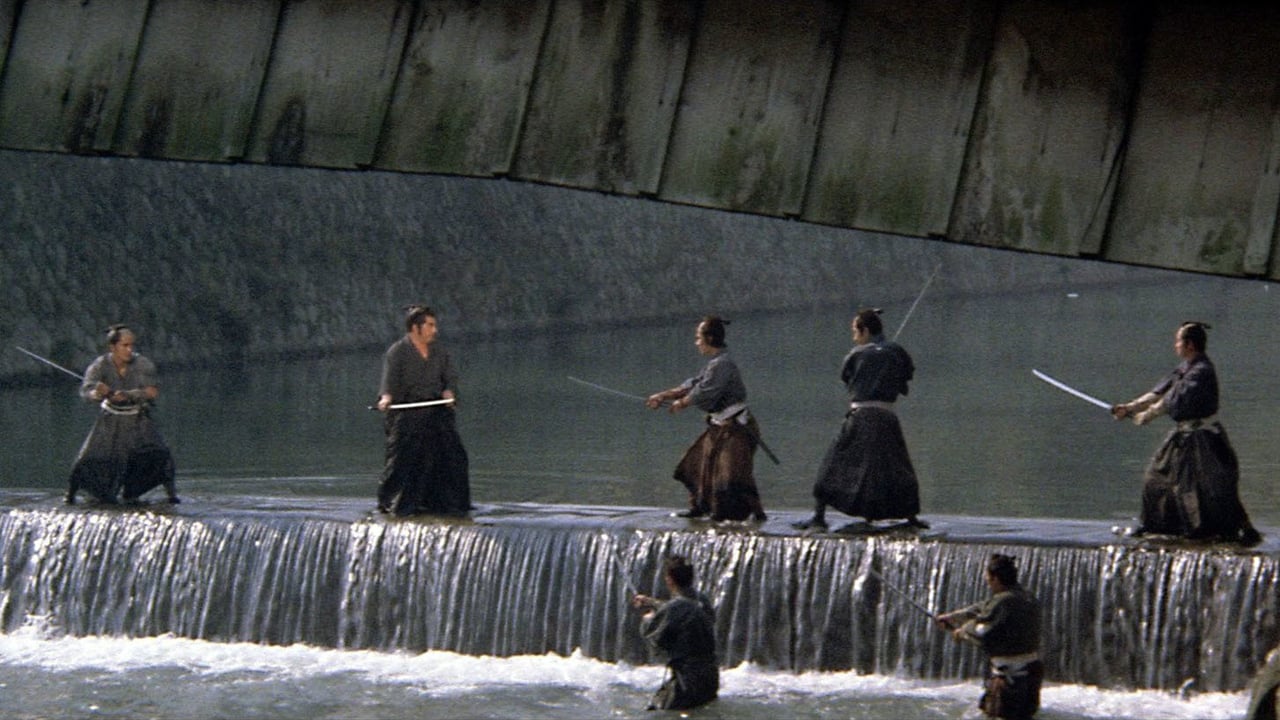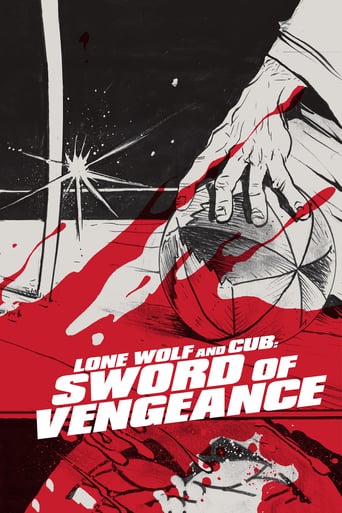Laikals
The greatest movie ever made..!
Brennan Camacho
Mostly, the movie is committed to the value of a good time.
Gary
The movie's not perfect, but it sticks the landing of its message. It was engaging - thrilling at times - and I personally thought it was a great time.
John Doe
The movie is long and dull with no character development and a boring story. Yawn. I wont be watching the rest of the series.I give Lone Wolf and Cub: Sword of Vengence a 3/10
Blueghost
I'm not sure what it is with the Japanese and samurai films. There's nudity, there's lots of limbs getting slashed, lots of blood shed, sometimes spurting out like a fountain, sex, and lots of artistic cinematography for a genre that's not much more than a Japanese western, so to speak. That is to say just as there's a lot of Westerns that have pretty basic stories, but are also well shot and acted, so it is that Lone Wolf and Cub falls into the same realm in terms of pulp cinema, only it's swords instead of six-shooters, and of course it takes place in 19th century Japan instead of the old west (19th century USA).There's a ton of artistry that has gone into the shooting of these films. Shots are carefully staged, though by this time one gets the sense that the cinematic lexicon for Samurai films was less art and more science, or that is to say the people doing the actual shooting knew what shots to set up to accentuate emotions for given scenes. Having said that, the films are well put together, but it's only with this first film in the series that we get a sense of the main character's drive; i.e. who he is, what he is about, and what propels him forward. After this film it's more or less a series of adventure episodes that don't go beyond the Ottami character carrying out contracts, and dazzling the audience with katana theatrics. Still, you can't help but appreciate the spectacle that are these films, and the bluray transfer and restoration makes them look extreme vivid. The viewer can see imperfections in the actor's skin, the sweat as it beads down over acne or pours, the viewer can discern different fabrics and a whole host of visual detail that should enhance the viewing experience.The only down shot to the samurai genre is that it is rather cliché once you get past looking into the main character. For all the fights (sometimes just slaughter, some of which is almost cartoon- like in execution, it borders on being ridiculous, and might be given the right unappreciative audience), there's not much introspection as to why the conflicts are taking place. And this is where the "cliche factor" falls into place, for just as American westerns usually deal with outlaws, so are we too here given the Japanese version of the such. And then on top of that, unlike American westerns were sometimes the gunmen seem to have revolvers that never need to be reloaded, we get a samurai and his child taking on sometimes entire armies of swordsmen. The acting is typical over-the-top Japanese style, but works for what it is (mostly anyway), and the more prosaic or less theatrical fights where it's just the main character going against another swordsman, are okay. But the more super-human feats seem to push the films into the unbelievable category, and this comes from a guy who loves science fiction from the 1960s, where SFX technology was not at its peak.For me, well, I found the films interesting for what they are, but I can't say that I'm a fan of them. I'd heard about them over the years, and seen the Americanized version of the comic books (manga) here and there, and now having seen most of the films, and liking the samurai genre, I think I can say I see why they were such a big success in Japan, but I also see them as being borderline comical; i.e. almost falling into the "awe come-on" area of stretching or breaking suspension of disbelief.Still, if you're into samurai films, then maybe check first one out and see what you think.Give it a shot.
Leofwine_draca
Having previously only seen SHOGUN ASSASSIN, I was pleased to finally get the chance to sit down and watch the entire six-film Lone Wolf & Cub series, beginning with this, the first entry. I was hoping for a treat, and with this film, I got one! It's a brilliantly conceived historical adventure film, blessed with Toho's fantastic production values and some truly lush cinematography. It follows the action template of cinema perfectly and is one of the most purely enjoyable samurai movies I've yet seen. A simple film, full of action and event, and yet at the same time it serves as a moral critique of Japan's violent and impassioned feudal era for those who like to look deeper into their films.The revenge story is well crafted and the film packed with many larger than life characters: prostitutes, bandits, mad women, noble warriors, and frightened villagers. Towering over all these are the central twosome, with Tomisaburo Wakayama as the typically 'stony-faced' Japanese assassin and Akihiro Tomikawa as his absolutely gorgeous and lovable son. The film is dotted with superb action sequences full of the usual blood-spurting swordplay and in addition the backdrops are beautifully shot, making this a sumptuous film to watch. Along with the violence, there's plenty of female nudity and sex along the way, so exploitation fans will be in heaven. There's a slow twenty minutes or so before the climax, but aside from that it's a classic film: one that feels stylish and epic throughout, despite the adult themes. I can't wait to watch the sequel!
morrison-dylan-fan
Reading an article in the UK film mag The Dark Side about the Video Nasty titles,I spotted a mention about an infamous Japanese samurai movie called Shogun Assassin.Searching round online,I was surprised to find out that Shogun was a composite of two films in a series.Whilst looking round for info on the series,I discovered that a Region 1 version of the first film in the series was being sold on Ebay,which led to me getting ready to meet the lone wolf and the cub for the first time.The plot:Vowing to get revenge on those who murdered his wife after he killed a Daimyo,Itto takes his young son Daigoro along with him,as they travel from one clan controlled village to the other.Getting into contact with a clan leader,Itto is hired to assassinate a rival clan leader's gang.Taking on the job, (even after facing two hidden would-be assassins!)Daigoro and Itto travel to the destination,where they discover that the clan leader is allowing all of his gang to murder the villagers,which leads to Itto setting his sights on getting revenge for himself and the villagers. View on the film:Based on Kazuo Koike and Goseki Kojima's Manga series,director Kenji Misumi & cinematographer Chikashi Makiura keep a strong root to the movies comic book origins,with Misumi covering Itto in deep shadows which give the title a striking depth of field.Closely working with editor Toshio Taniguchi,Misumi displays a razor sharp ear for silence which gives the red mist sprays and exposure of female flesh an unexpected poetic atmosphere,as Misumi's long, stilted wide shots cast the action against a warm, earthy backdrop,which is cut with the slashing of Itto's sword.Adapting their Manga series,the screenplay by Kazuo Koike & Goseki Kojima disappointingly fails to give each of the clans and ronin gangs clear distinctive features,with the mad Yagyū Retsudo being the only samurai to stand out from the blended in crowd. Bringing their creation to life,the writers give Itto and Daigoro on the road adventures a wry sense of humour,as the duo run into everything from a Norse-God looking ronin,to a desperate to breastfeed mad women.Spending most of the film acting with a child who does not speak any dialogue, Tomisaburô Wakayama gives an excellent performance as Itto,thanks to Wakayama keeping the death of Itto's wife pressing down on his sombre shoulders during stylised ronin battles,as the lone wolf sets out to protect his cub.

